Strategies and Analysis for an IoT-Based Healthcare System Development
VerifiedAdded on 2023/04/24
|7
|1220
|214
Report
AI Summary
This report provides a comprehensive system analysis of an IoT-based healthcare system. It explores various development strategies, including top-down, bottom-up, and structured design approaches, detailing their advantages and disadvantages. The report emphasizes the importance of requirement elicitation techniques such as prototyping, interviews, and user observations to ensure a fully functional system. It justifies the use of an IoT-based system in healthcare by highlighting its potential to streamline diagnostic processes, enhance data security, improve efficiency, and increase patient satisfaction. The conclusion underscores the benefits of the proposed system in terms of data security and improved patient care, suggesting that the IoT-based system offers a superior approach to disease diagnosis compared to traditional methods. The paper also includes references to support the analysis.
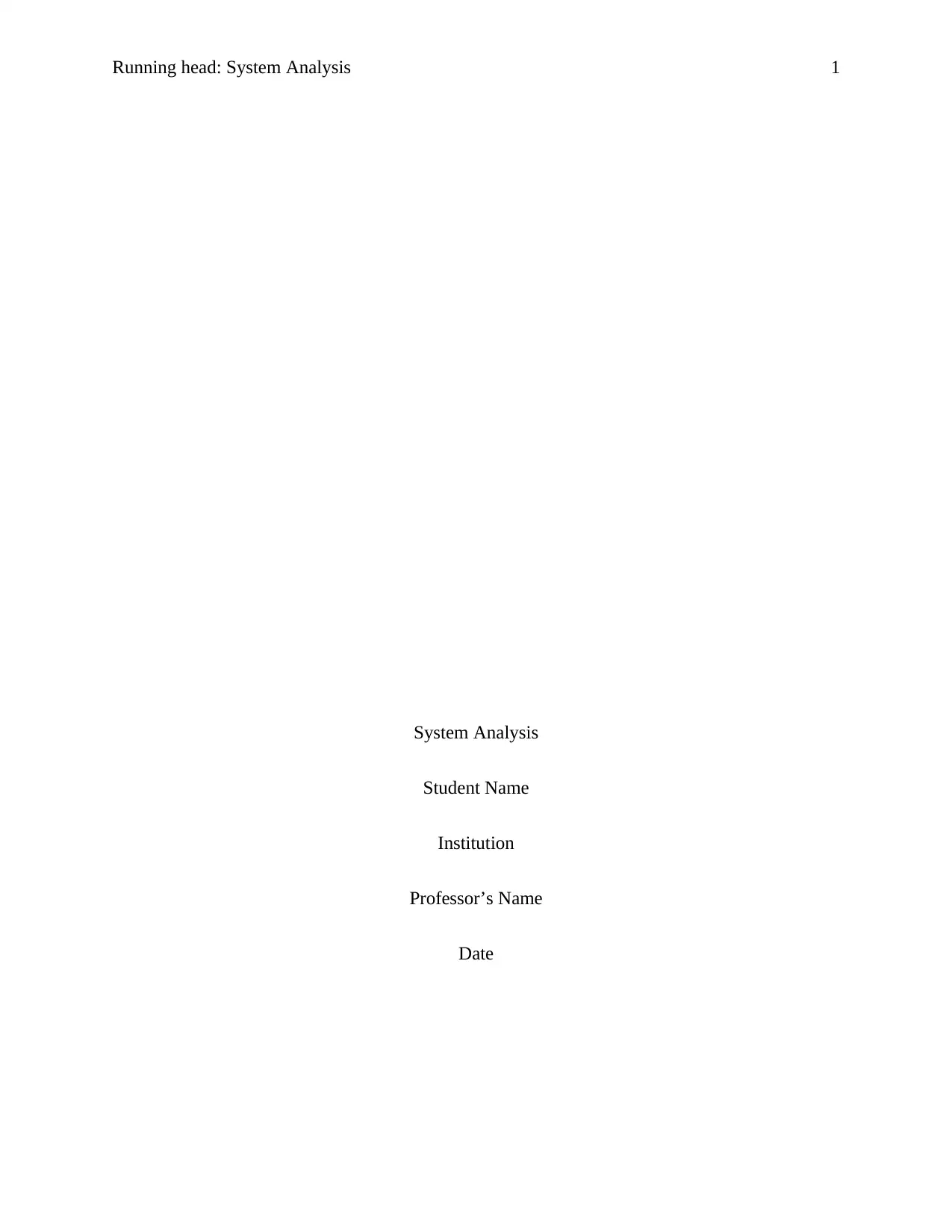
Running head: System Analysis 1
System Analysis
Student Name
Institution
Professor’s Name
Date
System Analysis
Student Name
Institution
Professor’s Name
Date
Paraphrase This Document
Need a fresh take? Get an instant paraphrase of this document with our AI Paraphraser
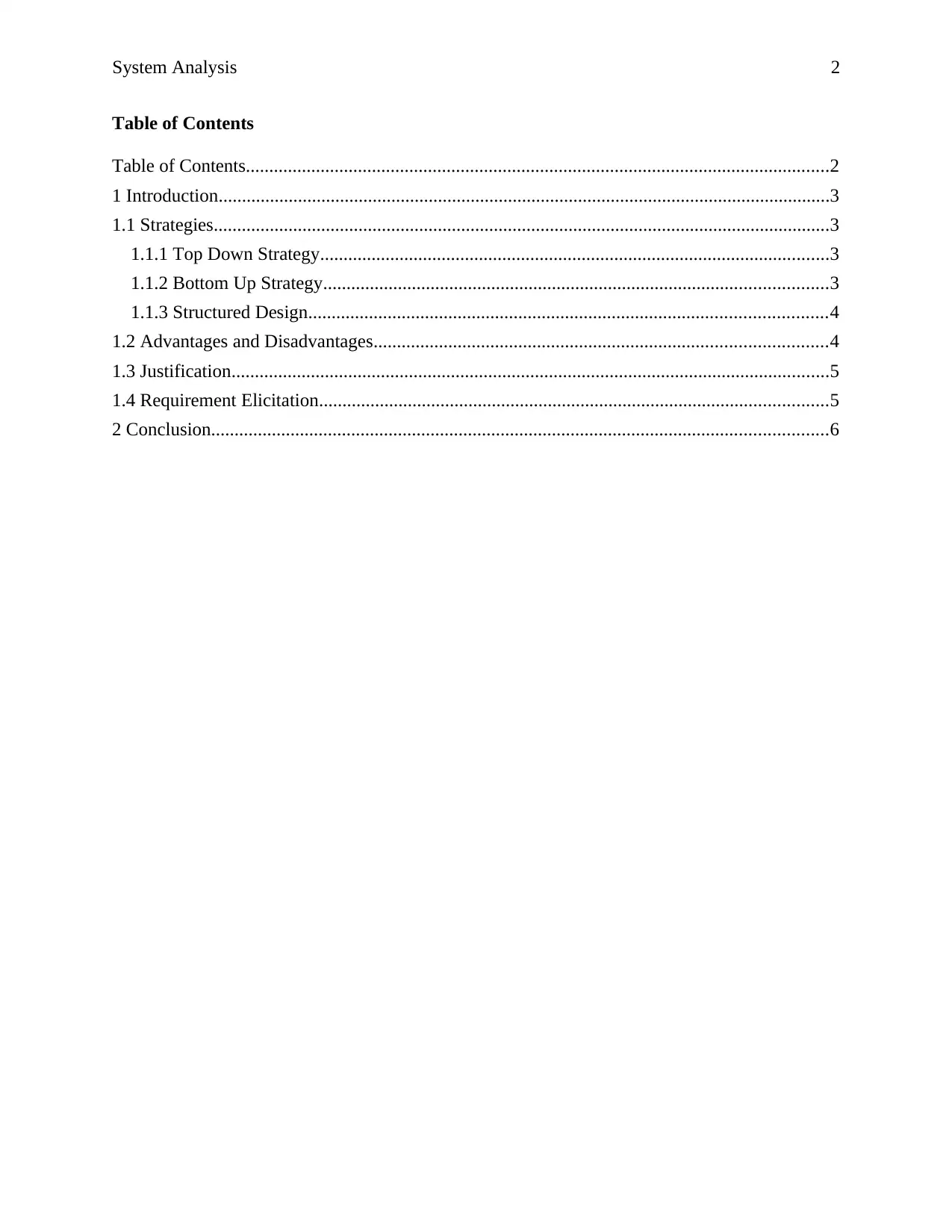
System Analysis 2
Table of Contents
Table of Contents.............................................................................................................................2
1 Introduction...................................................................................................................................3
1.1 Strategies....................................................................................................................................3
1.1.1 Top Down Strategy.............................................................................................................3
1.1.2 Bottom Up Strategy............................................................................................................3
1.1.3 Structured Design...............................................................................................................4
1.2 Advantages and Disadvantages.................................................................................................4
1.3 Justification................................................................................................................................5
1.4 Requirement Elicitation.............................................................................................................5
2 Conclusion....................................................................................................................................6
Table of Contents
Table of Contents.............................................................................................................................2
1 Introduction...................................................................................................................................3
1.1 Strategies....................................................................................................................................3
1.1.1 Top Down Strategy.............................................................................................................3
1.1.2 Bottom Up Strategy............................................................................................................3
1.1.3 Structured Design...............................................................................................................4
1.2 Advantages and Disadvantages.................................................................................................4
1.3 Justification................................................................................................................................5
1.4 Requirement Elicitation.............................................................................................................5
2 Conclusion....................................................................................................................................6
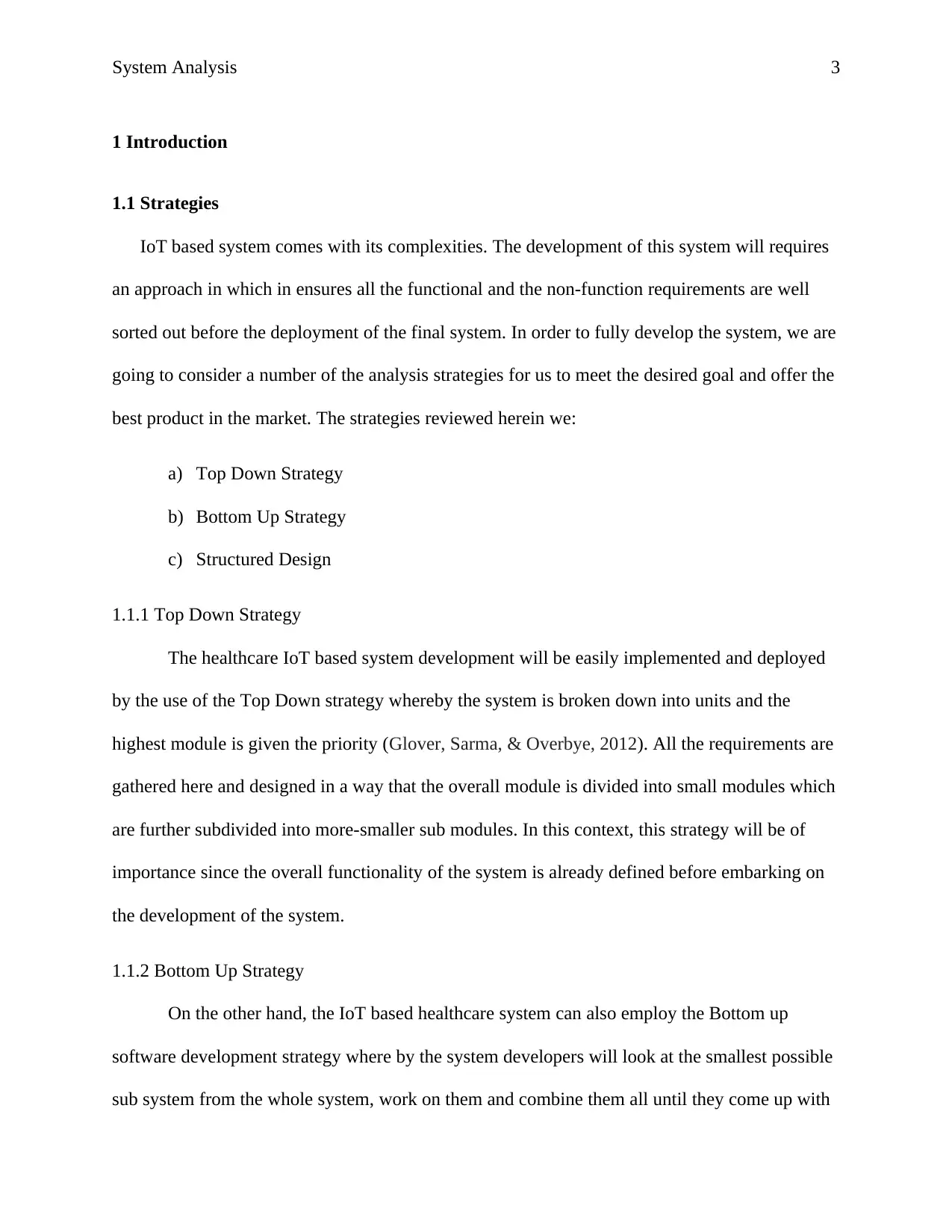
System Analysis 3
1 Introduction
1.1 Strategies
IoT based system comes with its complexities. The development of this system will requires
an approach in which in ensures all the functional and the non-function requirements are well
sorted out before the deployment of the final system. In order to fully develop the system, we are
going to consider a number of the analysis strategies for us to meet the desired goal and offer the
best product in the market. The strategies reviewed herein we:
a) Top Down Strategy
b) Bottom Up Strategy
c) Structured Design
1.1.1 Top Down Strategy
The healthcare IoT based system development will be easily implemented and deployed
by the use of the Top Down strategy whereby the system is broken down into units and the
highest module is given the priority (Glover, Sarma, & Overbye, 2012). All the requirements are
gathered here and designed in a way that the overall module is divided into small modules which
are further subdivided into more-smaller sub modules. In this context, this strategy will be of
importance since the overall functionality of the system is already defined before embarking on
the development of the system.
1.1.2 Bottom Up Strategy
On the other hand, the IoT based healthcare system can also employ the Bottom up
software development strategy where by the system developers will look at the smallest possible
sub system from the whole system, work on them and combine them all until they come up with
1 Introduction
1.1 Strategies
IoT based system comes with its complexities. The development of this system will requires
an approach in which in ensures all the functional and the non-function requirements are well
sorted out before the deployment of the final system. In order to fully develop the system, we are
going to consider a number of the analysis strategies for us to meet the desired goal and offer the
best product in the market. The strategies reviewed herein we:
a) Top Down Strategy
b) Bottom Up Strategy
c) Structured Design
1.1.1 Top Down Strategy
The healthcare IoT based system development will be easily implemented and deployed
by the use of the Top Down strategy whereby the system is broken down into units and the
highest module is given the priority (Glover, Sarma, & Overbye, 2012). All the requirements are
gathered here and designed in a way that the overall module is divided into small modules which
are further subdivided into more-smaller sub modules. In this context, this strategy will be of
importance since the overall functionality of the system is already defined before embarking on
the development of the system.
1.1.2 Bottom Up Strategy
On the other hand, the IoT based healthcare system can also employ the Bottom up
software development strategy where by the system developers will look at the smallest possible
sub system from the whole system, work on them and combine them all until they come up with
⊘ This is a preview!⊘
Do you want full access?
Subscribe today to unlock all pages.

Trusted by 1+ million students worldwide
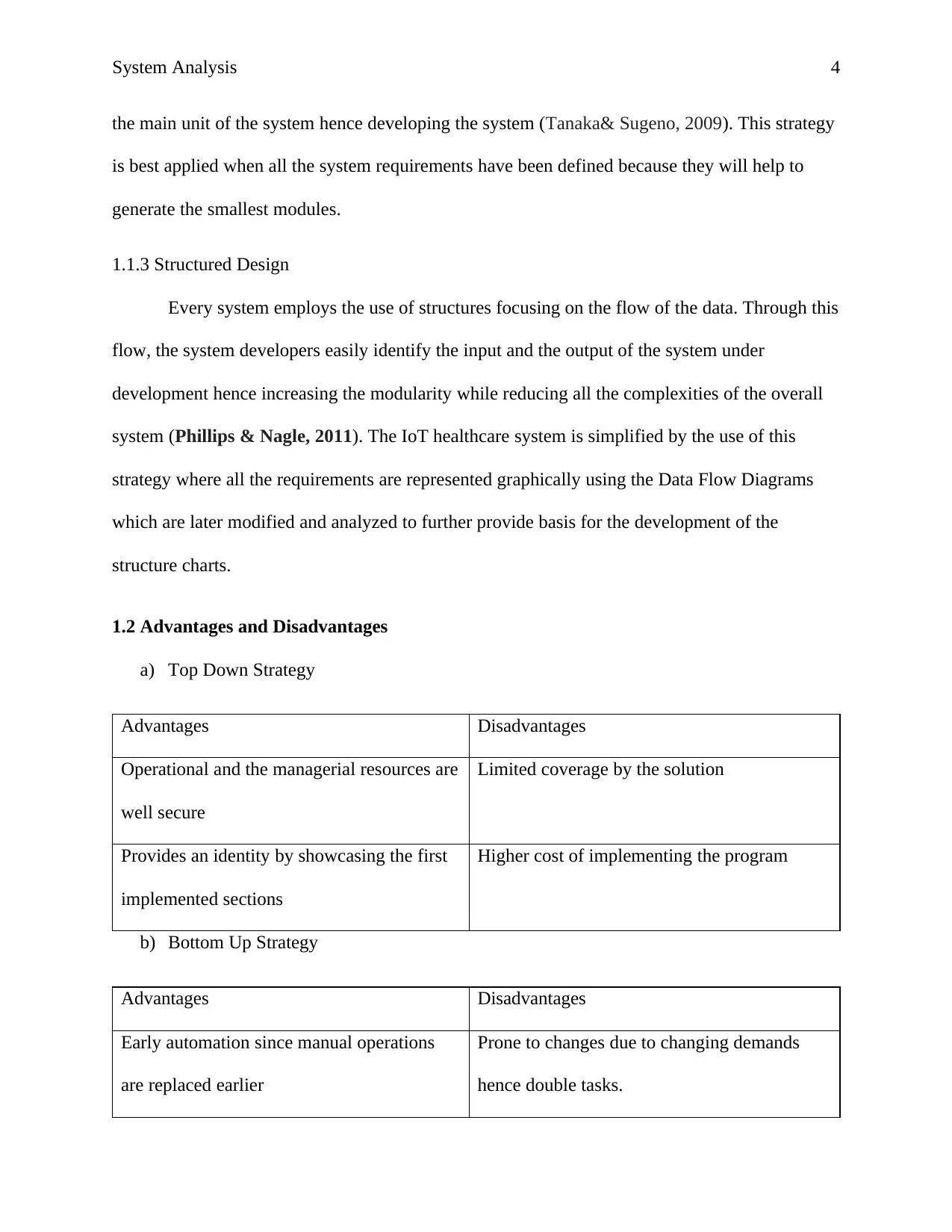
System Analysis 4
the main unit of the system hence developing the system (Tanaka& Sugeno, 2009). This strategy
is best applied when all the system requirements have been defined because they will help to
generate the smallest modules.
1.1.3 Structured Design
Every system employs the use of structures focusing on the flow of the data. Through this
flow, the system developers easily identify the input and the output of the system under
development hence increasing the modularity while reducing all the complexities of the overall
system (Phillips & Nagle, 2011). The IoT healthcare system is simplified by the use of this
strategy where all the requirements are represented graphically using the Data Flow Diagrams
which are later modified and analyzed to further provide basis for the development of the
structure charts.
1.2 Advantages and Disadvantages
a) Top Down Strategy
Advantages Disadvantages
Operational and the managerial resources are
well secure
Limited coverage by the solution
Provides an identity by showcasing the first
implemented sections
Higher cost of implementing the program
b) Bottom Up Strategy
Advantages Disadvantages
Early automation since manual operations
are replaced earlier
Prone to changes due to changing demands
hence double tasks.
the main unit of the system hence developing the system (Tanaka& Sugeno, 2009). This strategy
is best applied when all the system requirements have been defined because they will help to
generate the smallest modules.
1.1.3 Structured Design
Every system employs the use of structures focusing on the flow of the data. Through this
flow, the system developers easily identify the input and the output of the system under
development hence increasing the modularity while reducing all the complexities of the overall
system (Phillips & Nagle, 2011). The IoT healthcare system is simplified by the use of this
strategy where all the requirements are represented graphically using the Data Flow Diagrams
which are later modified and analyzed to further provide basis for the development of the
structure charts.
1.2 Advantages and Disadvantages
a) Top Down Strategy
Advantages Disadvantages
Operational and the managerial resources are
well secure
Limited coverage by the solution
Provides an identity by showcasing the first
implemented sections
Higher cost of implementing the program
b) Bottom Up Strategy
Advantages Disadvantages
Early automation since manual operations
are replaced earlier
Prone to changes due to changing demands
hence double tasks.
Paraphrase This Document
Need a fresh take? Get an instant paraphrase of this document with our AI Paraphraser
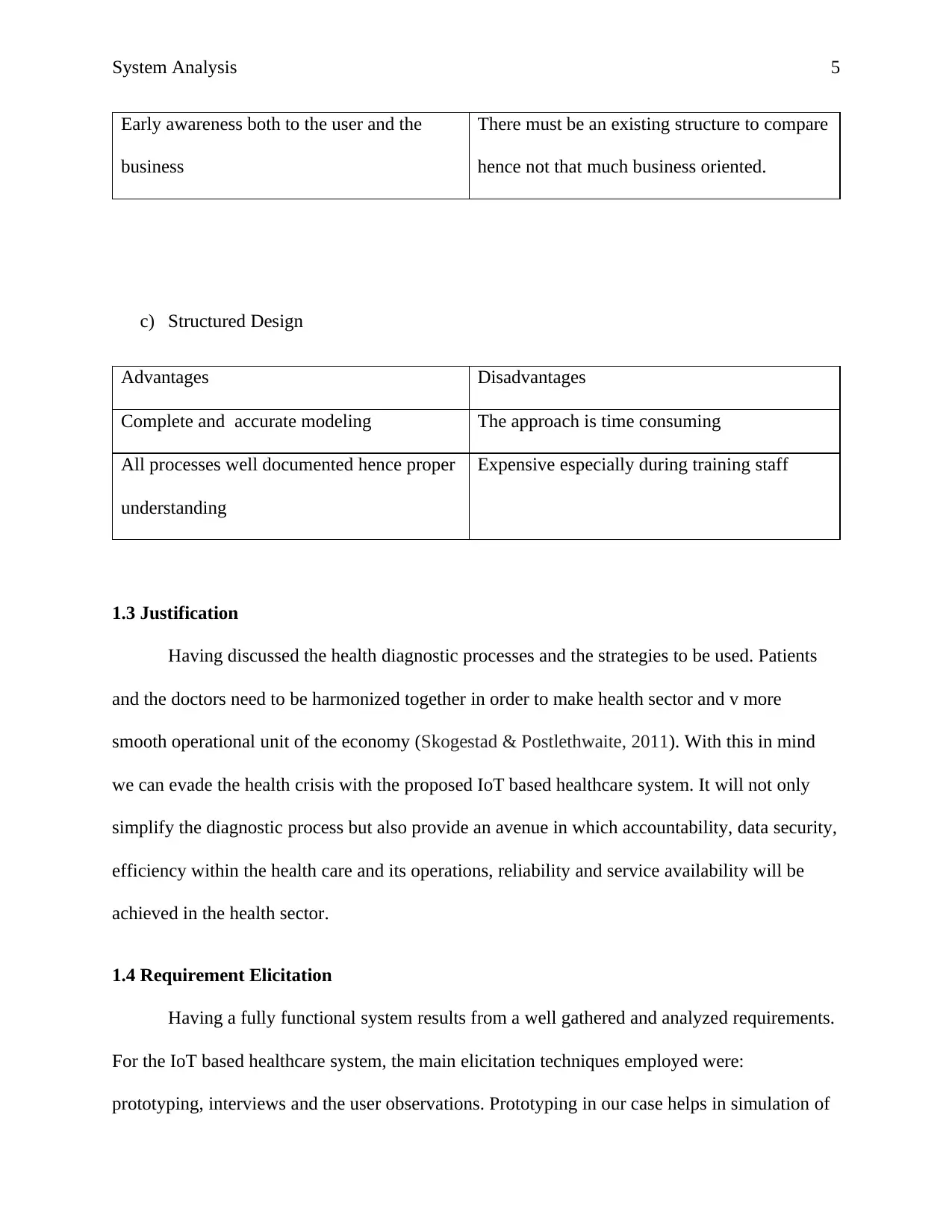
System Analysis 5
Early awareness both to the user and the
business
There must be an existing structure to compare
hence not that much business oriented.
c) Structured Design
Advantages Disadvantages
Complete and accurate modeling The approach is time consuming
All processes well documented hence proper
understanding
Expensive especially during training staff
1.3 Justification
Having discussed the health diagnostic processes and the strategies to be used. Patients
and the doctors need to be harmonized together in order to make health sector and v more
smooth operational unit of the economy (Skogestad & Postlethwaite, 2011). With this in mind
we can evade the health crisis with the proposed IoT based healthcare system. It will not only
simplify the diagnostic process but also provide an avenue in which accountability, data security,
efficiency within the health care and its operations, reliability and service availability will be
achieved in the health sector.
1.4 Requirement Elicitation
Having a fully functional system results from a well gathered and analyzed requirements.
For the IoT based healthcare system, the main elicitation techniques employed were:
prototyping, interviews and the user observations. Prototyping in our case helps in simulation of
Early awareness both to the user and the
business
There must be an existing structure to compare
hence not that much business oriented.
c) Structured Design
Advantages Disadvantages
Complete and accurate modeling The approach is time consuming
All processes well documented hence proper
understanding
Expensive especially during training staff
1.3 Justification
Having discussed the health diagnostic processes and the strategies to be used. Patients
and the doctors need to be harmonized together in order to make health sector and v more
smooth operational unit of the economy (Skogestad & Postlethwaite, 2011). With this in mind
we can evade the health crisis with the proposed IoT based healthcare system. It will not only
simplify the diagnostic process but also provide an avenue in which accountability, data security,
efficiency within the health care and its operations, reliability and service availability will be
achieved in the health sector.
1.4 Requirement Elicitation
Having a fully functional system results from a well gathered and analyzed requirements.
For the IoT based healthcare system, the main elicitation techniques employed were:
prototyping, interviews and the user observations. Prototyping in our case helps in simulation of
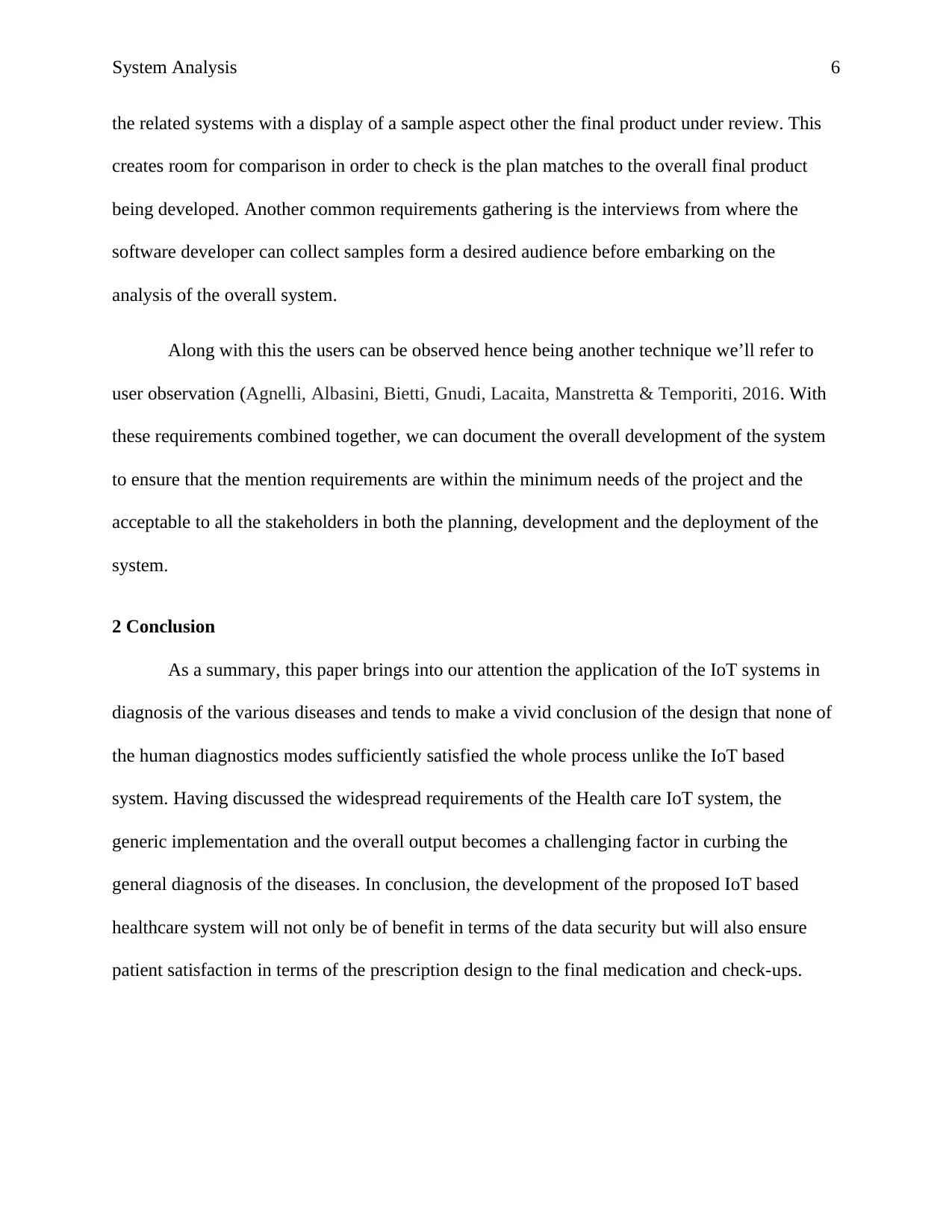
System Analysis 6
the related systems with a display of a sample aspect other the final product under review. This
creates room for comparison in order to check is the plan matches to the overall final product
being developed. Another common requirements gathering is the interviews from where the
software developer can collect samples form a desired audience before embarking on the
analysis of the overall system.
Along with this the users can be observed hence being another technique we’ll refer to
user observation (Agnelli, Albasini, Bietti, Gnudi, Lacaita, Manstretta & Temporiti, 2016. With
these requirements combined together, we can document the overall development of the system
to ensure that the mention requirements are within the minimum needs of the project and the
acceptable to all the stakeholders in both the planning, development and the deployment of the
system.
2 Conclusion
As a summary, this paper brings into our attention the application of the IoT systems in
diagnosis of the various diseases and tends to make a vivid conclusion of the design that none of
the human diagnostics modes sufficiently satisfied the whole process unlike the IoT based
system. Having discussed the widespread requirements of the Health care IoT system, the
generic implementation and the overall output becomes a challenging factor in curbing the
general diagnosis of the diseases. In conclusion, the development of the proposed IoT based
healthcare system will not only be of benefit in terms of the data security but will also ensure
patient satisfaction in terms of the prescription design to the final medication and check-ups.
the related systems with a display of a sample aspect other the final product under review. This
creates room for comparison in order to check is the plan matches to the overall final product
being developed. Another common requirements gathering is the interviews from where the
software developer can collect samples form a desired audience before embarking on the
analysis of the overall system.
Along with this the users can be observed hence being another technique we’ll refer to
user observation (Agnelli, Albasini, Bietti, Gnudi, Lacaita, Manstretta & Temporiti, 2016. With
these requirements combined together, we can document the overall development of the system
to ensure that the mention requirements are within the minimum needs of the project and the
acceptable to all the stakeholders in both the planning, development and the deployment of the
system.
2 Conclusion
As a summary, this paper brings into our attention the application of the IoT systems in
diagnosis of the various diseases and tends to make a vivid conclusion of the design that none of
the human diagnostics modes sufficiently satisfied the whole process unlike the IoT based
system. Having discussed the widespread requirements of the Health care IoT system, the
generic implementation and the overall output becomes a challenging factor in curbing the
general diagnosis of the diseases. In conclusion, the development of the proposed IoT based
healthcare system will not only be of benefit in terms of the data security but will also ensure
patient satisfaction in terms of the prescription design to the final medication and check-ups.
⊘ This is a preview!⊘
Do you want full access?
Subscribe today to unlock all pages.

Trusted by 1+ million students worldwide
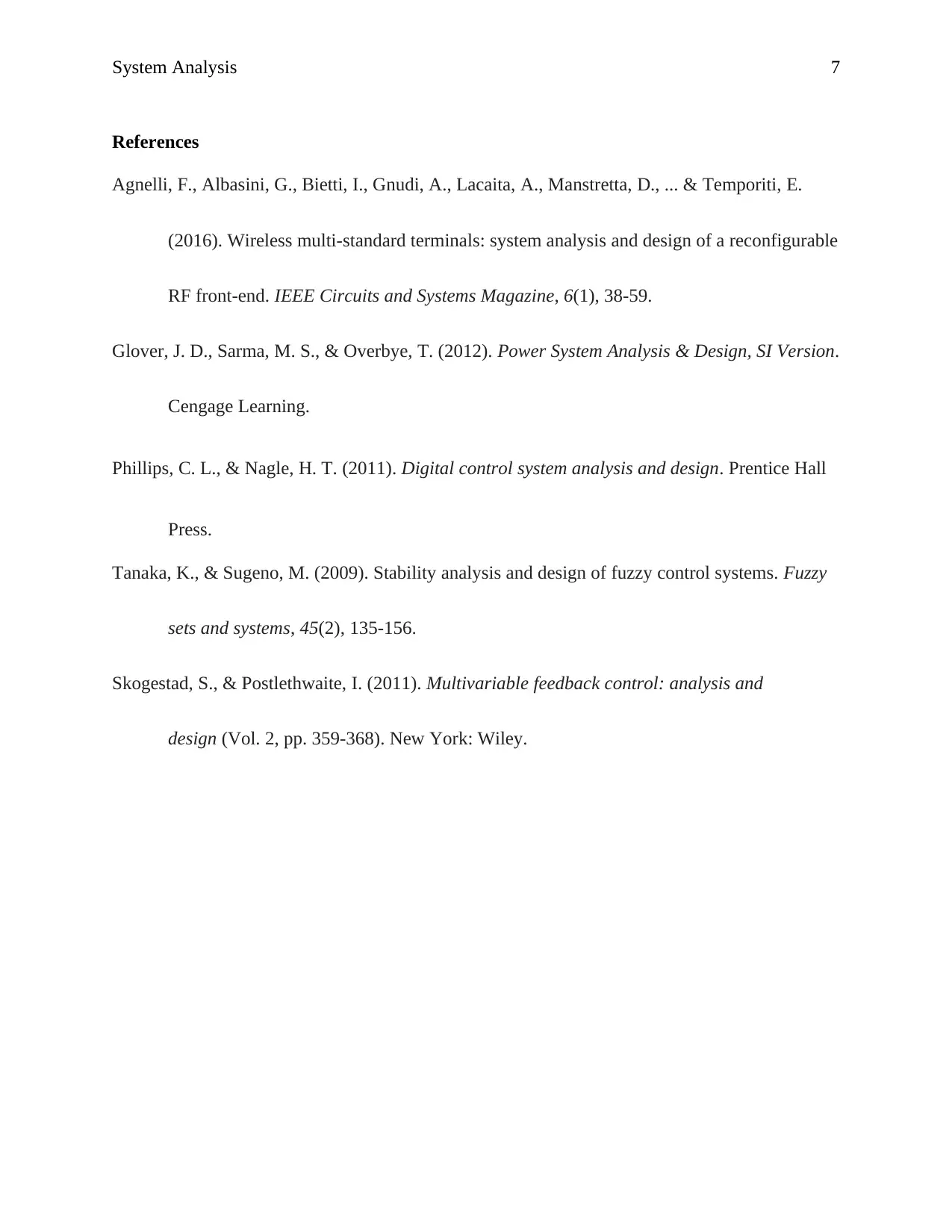
System Analysis 7
References
Agnelli, F., Albasini, G., Bietti, I., Gnudi, A., Lacaita, A., Manstretta, D., ... & Temporiti, E.
(2016). Wireless multi-standard terminals: system analysis and design of a reconfigurable
RF front-end. IEEE Circuits and Systems Magazine, 6(1), 38-59.
Glover, J. D., Sarma, M. S., & Overbye, T. (2012). Power System Analysis & Design, SI Version.
Cengage Learning.
Phillips, C. L., & Nagle, H. T. (2011). Digital control system analysis and design. Prentice Hall
Press.
Tanaka, K., & Sugeno, M. (2009). Stability analysis and design of fuzzy control systems. Fuzzy
sets and systems, 45(2), 135-156.
Skogestad, S., & Postlethwaite, I. (2011). Multivariable feedback control: analysis and
design (Vol. 2, pp. 359-368). New York: Wiley.
References
Agnelli, F., Albasini, G., Bietti, I., Gnudi, A., Lacaita, A., Manstretta, D., ... & Temporiti, E.
(2016). Wireless multi-standard terminals: system analysis and design of a reconfigurable
RF front-end. IEEE Circuits and Systems Magazine, 6(1), 38-59.
Glover, J. D., Sarma, M. S., & Overbye, T. (2012). Power System Analysis & Design, SI Version.
Cengage Learning.
Phillips, C. L., & Nagle, H. T. (2011). Digital control system analysis and design. Prentice Hall
Press.
Tanaka, K., & Sugeno, M. (2009). Stability analysis and design of fuzzy control systems. Fuzzy
sets and systems, 45(2), 135-156.
Skogestad, S., & Postlethwaite, I. (2011). Multivariable feedback control: analysis and
design (Vol. 2, pp. 359-368). New York: Wiley.
1 out of 7
Related Documents
Your All-in-One AI-Powered Toolkit for Academic Success.
+13062052269
info@desklib.com
Available 24*7 on WhatsApp / Email
![[object Object]](/_next/static/media/star-bottom.7253800d.svg)
Unlock your academic potential
Copyright © 2020–2025 A2Z Services. All Rights Reserved. Developed and managed by ZUCOL.





